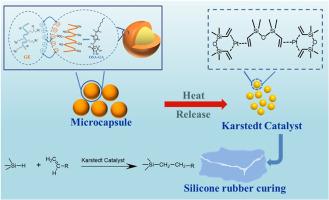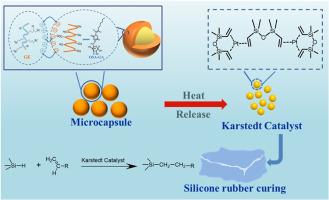新型Karstedt催化剂复合微胶囊:一种基于有机胶的中温硫化硅橡胶潜绿微胶囊
IF 4.5
2区 化学
Q2 POLYMER SCIENCE
引用次数: 0
摘要
针对传统加成-固化硅橡胶体系中存在的固化温度高(100-200℃)、产品颜色退化、催化剂抑制剂导致的过程可控性不足等问题,提出了一种基于微胶囊技术的绿色改性新策略。采用复合聚合技术,以明胶(GE)/辛烯基丁二酸酐改性阿拉伯胶(OSA-GA)为壳层,Karstedt催化剂为核心,成功开发了一种新型微胶囊体系。该壁的组成具有双重优势:一是有效防止催化剂与基体之间的预反应,从而将室温下的储存时间从40分钟显著延长至20小时;二是根据壁的特定软化温度(60℃),可以显著降低固化温度。研究了工艺参数对微胶囊形貌和功能的影响,并通过傅里叶变换红外光谱(FTIR)、扫描电镜(SEM)和热重分析(TGA)验证了微胶囊具有一致的核壳结构和优异的热响应性能。该微胶囊化体系在保持硅橡胶机械性能的同时,可将固化温度降低至60℃,且不会引入有毒物质。该研究为开发环境友好、室温稳定的硅橡胶体系提供了有效的策略,具有重要的应用价值。本文章由计算机程序翻译,如有差异,请以英文原文为准。


Novel composite microcapsule for Karstedt catalyst: a latent green one based on organic gum for curing silicone rubber at medium temperature
In response to issues such as high curing temperatures (100–200°C), degradation of product color, and insufficient process controllability in traditional addition-curing silicone rubber systems caused by catalyst inhibitors, this study proposed a novel green modification strategy based on microcapsule technology. Through the use of a composite aggregation technique, an innovative microcapsule system was successfully developed, utilizing gelatin (GE)/octenyl succinic anhydride-modified gum arabic (OSA-GA) as the shell and Karstedt catalyst as the core. The composition of the wall provided dual advantages: effectively preventing the pre-reaction between the catalyst and the matrix, which would significantly extend the storage time at room temperature from 40 min to 20 h, and enable a significant reduction in curing temperature based on the specific softening temperature of the wall (at 60°C). The research methodically examined the impact of process parameters on the morphology and functionality of the microcapsules, and verified via Fourier transform infrared spectroscopy (FTIR), scanning electron microscopy (SEM), and thermogravimetric analysis (TGA) that the microcapsules featured consistent core-shell structure and superior thermal response properties. The microencapsulated system could reduce the curing temperature to 60°C while maintaining the mechanical properties of silicone rubber, without introducing toxic substances. The study provided a valid strategy for developing environmentally friendly, room-temperature-stable silicone rubber systems and hold significant application values.
求助全文
通过发布文献求助,成功后即可免费获取论文全文。
去求助
来源期刊

Polymer
化学-高分子科学
CiteScore
7.90
自引率
8.70%
发文量
959
审稿时长
32 days
期刊介绍:
Polymer is an interdisciplinary journal dedicated to publishing innovative and significant advances in Polymer Physics, Chemistry and Technology. We welcome submissions on polymer hybrids, nanocomposites, characterisation and self-assembly. Polymer also publishes work on the technological application of polymers in energy and optoelectronics.
The main scope is covered but not limited to the following core areas:
Polymer Materials
Nanocomposites and hybrid nanomaterials
Polymer blends, films, fibres, networks and porous materials
Physical Characterization
Characterisation, modelling and simulation* of molecular and materials properties in bulk, solution, and thin films
Polymer Engineering
Advanced multiscale processing methods
Polymer Synthesis, Modification and Self-assembly
Including designer polymer architectures, mechanisms and kinetics, and supramolecular polymerization
Technological Applications
Polymers for energy generation and storage
Polymer membranes for separation technology
Polymers for opto- and microelectronics.
 求助内容:
求助内容: 应助结果提醒方式:
应助结果提醒方式:


